Drug Catalog - Product Detail
SOTALOL HCL (AFIB/AFL) TAB 80 MG 100 CT
| NDC | Mfr | Size | Str | Form |
|---|---|---|---|---|
| 42806-0121-01 | EPIC PHARMA | 100 | 80MG | TABLET |
PACKAGE FILES
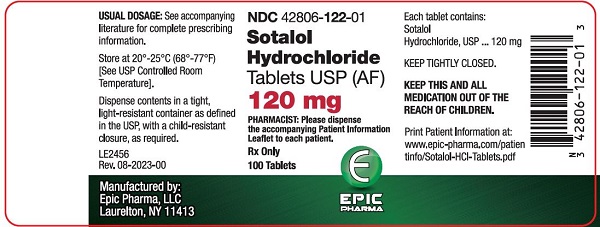


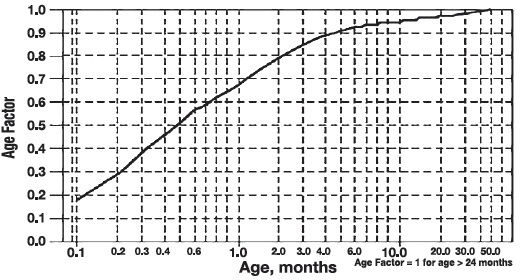
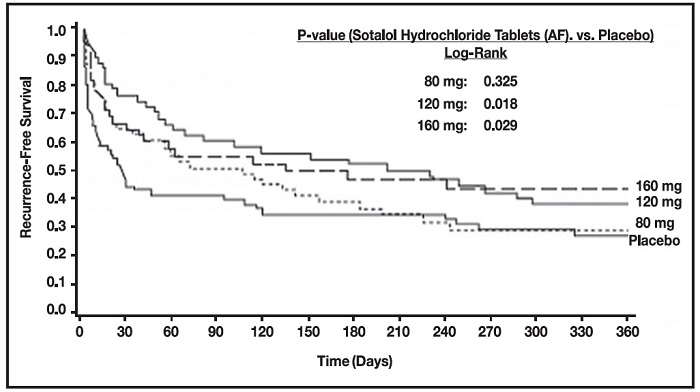
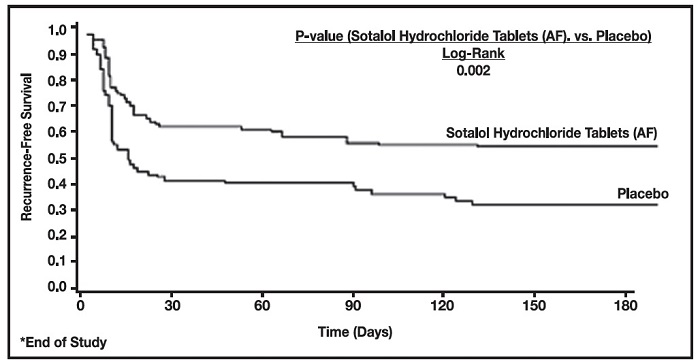
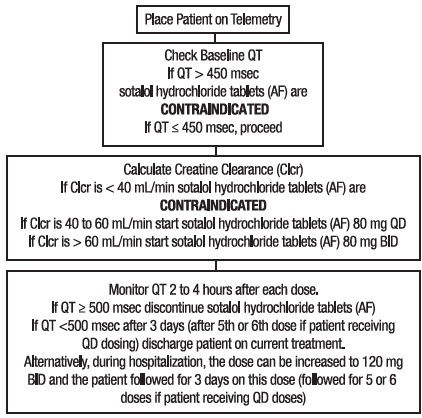

Generic Name
SOTALOL HYDROCHLORIDE
Substance Name
SOTALOL HYDROCHLORIDE
Product Type
HUMAN PRESCRIPTION DRUG
Route
ORAL
Application Number
ANDA077070
Description
DESCRIPTION Sotalol hydrochloride tablets, USP (AF) are an antiarrhythmic drug with Class II (beta-adrenoreceptor blocking) and Class III (cardiac action potential duration prolongation) properties. It is supplied as a white, capsule-shaped tablet for oral administration. Sotalol hydrochloride is a white, crystalline solid with a molecular weight of 308.8. It is hydrophilic, soluble in water, propylene glycol and ethanol, but is only slightly soluble in chloroform. Chemically, sotalol hydrochloride is d, l- N -[4-[1-hydroxy-2-[(1-methylethyl) amino]ethyl]phenyl] methanesulfonamide monohydrochloride. The molecular formula is C 12 H 20 N 2 O 3 S•HCl and is represented by the following structural formula: Sotalol hydrochloride tablets, USP (AF) contain the following inactive ingredients: pregelatinized starch, microcrystalline cellulose, lactose monohydrate, colloidal silicon dioxide, stearic acid, and magnesium stearate. structural-formula
How Supplied
HOW SUPPLIED Sotalol hydrochloride tablets USP (AF), 80 mg are white, capsule-shaped tablets, debossed “ Є ” to the left of bisect and “121” to the right of bisect on one side and plain on the other side, available in bottles of 100 and 1000. Sotalol hydrochloride tablets USP (AF), 120 mg are white, capsule-shaped tablets, debossed “ Є ” to the left of bisect and “122” to the right of bisect on one side and plain on the other side, available in bottles of 100 and 1000. Sotalol hydrochloride tablets USP (AF), 160 mg are white, capsule-shaped tablets, debossed “ Є ” to the left of bisect and “123” to the right of bisect on one side and plain on the other side, available in bottles of 100 and 1000. Store at 20° to 25°C (68° to 77°F); [see USP Controlled Room Temperature]. Dispense in a tight container as defined in the USP, with a child-resistant closure as required. Dispense with Patient Information available at: www.epic-pharma.com/patientinfo/Sotalol-HCl-Tablets.pdf Rev. 08-2023-00 MF121REV08/23 OE1385
Indications & Usage
INDICATIONS AND USAGE Sotalol hydrochloride tablets (AF) are indicated for the maintenance of normal sinus rhythm [delay in time to recurrence of atrial fibrillation/atrial flutter (AFIB/AFL)] in patients with symptomatic AFIB/AFL who are currently in sinus rhythm. Because sotalol hydrochloride tablets (AF) can cause life-threatening ventricular arrhythmias, it should be reserved for patients in whom AFIB/AFL is highly symptomatic. Patients with paroxysmal AFIB whose AFIB/AFL that is easily reversed (by Valsalva maneuver, for example) should usually not be given sotalol hydrochloride tablets (AF) (see WARNINGS ). In general, antiarrhythmic therapy for AFIB/AFL aims to prolong the time in normal sinus rhythm. Recurrence is expected in some patients (see Clinical Studies ). Sotalol hydrochloride tablets (AF) are also indicated for the treatment of documented life-threatening ventricular arrhythmias and is marketed under the brand name Betapace ® (sotalol hydrochloride tablets) . Sotalol hydrochloride tablets , however, must not be substituted for sotalol hydrochloride tablets (AF) because of significant differences in labeling (i.e., patient package insert, dosing administration and safety information).
Dosage and Administration
DOSAGE AND ADMINISTRATION Dosing and Administration in Adults • Therapy with sotalol (AF) must be initiated (and, if necessary, titrated) in a setting that provides continuous electrocardiographic (ECG) monitoring and in the presence of personnel trained in the management of serious ventricular arrhythmias. Patients should continue to be monitored in this way for a minimum of 3 days on the maintenance dose. In addition, patients should not be discharged within 12 hours of electrical or pharmacological conversion to normal sinus rhythm. • The QT interval is used to determine patient eligibility for sotalol hydrochloride tablet (AF) treatment and for monitoring safety during treatment. The baseline QT interval must be ≤450 msec in order for a patient to be started on sotalol hydrochloride tablet (AF) therapy. During initiation and titration, the QT interval should be monitored 2-4 hours after each dose. If the QT interval prolongs to 500 msec or greater, the dose must be reduced or the drug discontinued. • The dose of sotalol hydrochloride tablets (AF) must be individualized according to calculated creatinine clearance. In patients with a creatinine clearance >60 mL/min sotalol hydrochloride tablets (AF) are administered twice daily (BID) while in those with a creatinine clearance between 40 and 60 mL/min, the dose is administered once daily (QD). In patients with a creatinine clearance less than 40 mL/min sotalol hydrochloride tablets (AF) are contraindicated. The recommended initial dose of sotalol hydrochloride tablets (AF) is 80 mg and is initiated as shown in the dosing algorithm described below. The 80 mg dose can be titrated upward to 120 mg during initial hospitalization or after discharge on 80 mg in the event of recurrence, by rehospitalization and repeating the same steps used during the initiation of therapy (see Upward Titration of Dose ). • Patients with atrial fibrillation should be anticoagulated according to usual medical practice. Hypokalemia should be corrected before initiation of sotalol hydrochloride tablet (AF) therapy (see WARNINGS, Ventricular Arrhythmia ). • Patients to be discharged on sotalol hydrochloride tablets (AF) therapy from an in-patient setting should have an adequate supply of sotalol hydrochloride tablets (AF), to allow uninterrupted therapy until the patient can fill a sotalol hydrochloride tablets (AF) prescription. Initiation of Sotalol Hydrochloride Tablets (AF) Therapy Step 1. Electrocardiographic assessment: Prior to administration of the first dose, the QT interval must be determined using an average of 5 beats. If the baseline QT is greater than 450 msec (JT ≥330 msec if QRS over 100 msec), sotalol hydrochloride tablets (AF) are contraindicated. Step 2. Calculation of creatinine clearance: Prior to the administration of the first dose, the patient's creatinine clearance should be calculated using the following formula: creatinine clearance (male) = (140-age) x body weight in kg 72 x serum creatinine (mg/dL) creatinine clearance (female) = (140-age) x body weight in kg x 0.85 72 x serum creatinine (mg/dL) When serum creatinine is given in µmol/L, divide the value by 88.4 (1 mg/dL = 88.4 µmol/L). Step 3. Starting Dose: The starting dose of sotalol hydrochloride tablets is 80 mg twice daily (BID) if the creatinine clearance is >60 mL/min, and 80 mg once daily (QD) if the creatinine clearance is 40-60 mL/min. If the creatinine clearance is <40 mL/min sotalol hydrochloride tablets (AF) are contraindicated. Step 4. Administer the appropriate daily dose of sotalol hydrochloride tablets (AF) and begin continuous ECG monitoring with QT interval measurements 2-4 hours after each dose. Step 5. If the 80 mg dose level is tolerated and the QT interval remains <500 msec after at least 3 days (after 5 or 6 doses if patient receiving QD dosing), the patient can be discharged. Alternatively, during hospitalization, the dose can be increased to 120 mg bid and the patient followed for 3 days on this dose (followed for 5 or 6 doses if patient receiving QD doses). The steps described above are summarized in the following diagram: steps in diagram Upward Titration of Dose If the 80 mg dose level (given BID or QD depending upon the creatinine clearance) does not reduce the frequency of relapses of AFIB/AFL and is tolerated without excessive QT interval prolongation (i.e., ≥520 msec), the dose level may be increased to 120 mg (BID or QD depending upon the creatinine clearance). As proarrhythmic events can occur not only at initiation of therapy, but also with each upward dosage adjustment, Steps 2 through 5 used during initiation of sotalol hydrochloride tablets (AF) therapy should be followed when increasing the dose level. In the U.S. multicenter dose-response study, the 120 mg dose (BID or QD) was found to be the most effective in prolonging the time to ECG documented symptomatic recurrence of AFIB/AFL. If the 120 mg dose does not reduce the frequency of early relapse of AFIB/AFL and is tolerated without excessive QT interval prolongation (≥520 msec), an increase to 160 mg (BID or QD depending upon the creatinine clearance), can be considered. Steps 2 through 5 used during the initiation of therapy should be used again to introduce such an increase. Maintenance of Sotalol Hydrochloride Tablet (AF) Therapy Renal function and QT should be re-evaluated regularly if medically warranted. If QT is 520 msec or greater (JT 430 msec or greater if QRS is > 100 msec), the dose of sotalol hydrochloride tablet (AF) therapy should be reduced and patients should be carefully monitored until QT returns to less than 520 msec. If the QT interval is ≥520 msec while on the lowest maintenance dose level (80 mg) the drug should be discontinued. If renal function deteriorates, reduce the daily dose in half by administering the drug once daily as described in Initiation of Sotalol Hydrochloride Tablet (AF) Therapy, Step 3. Special Considerations The maximum recommended dose in patients with a calculated creatinine clearance greater than 60 mL/min is 160 mg BID, doses greater than 160 mg BID have been associated with an increased incidence of Torsade de Pointes and are not recommended. A patient who misses a dose should NOT double the next dose. The next dose should be taken at the usual time. Dosing and Administration in Children As in adults the following precautionary measures should be considered when initiating sotalol treatment in children: initiation of treatment in the hospital after appropriate clinical assessment; individualized regimen as appropriate; gradual increase of doses if required; careful assessment of therapeutic response and tolerability; and frequent monitoring of the QT c interval and heart rate. For children aged about 2 years and greater For children aged about 2 years and greater, with normal renal function, doses normalized for body surface area are appropriate for both initial and incremental dosing. Since the Class III potency in children (see CLINICAL PHARMACOLOGY ) is not very different from that in adults, reaching plasma concentrations that occur within the adult dose range is an appropriate guide. From pediatric pharmacokinetic data the following is recommended. For initiation of treatment, 30 mg/m 2 three times a day (90 mg/m 2 total daily dose) is approximately equivalent to the initial 160 mg total daily dose for adults. Subsequent titration to a maximum of 60 mg/m 2 (approximately equivalent to the 360 mg total daily dose for adults) can then occur. Titration should be guided by clinical response, heart rate and QT c , with increased dosing being preferably carried out in-hospital. At least 36 hours should be allowed between dose increments to attain steady-state plasma concentrations of sotalol in patients with age-adjusted normal renal function. For children aged about 2 years or younger For children aged about 2 years or younger, the above pediatric dosage should be reduced by a factor that depends heavily upon age, as shown in the following graph, age plotted on a logarithmic scale in months. For a child aged 20 months, the dosing suggested for children with normal renal function aged 2 years or greater should be multiplied by about 0.97; the initial starting dose would be (30 X 0.97)=29.1 mg/m 2 , administered three times daily. For a child aged 1 month, the starting dose should be multiplied by 0.68; the initial starting dose would be (30 X 0.68)=20 mg/m 2 , administered three times daily. For a child aged about 1 week, the initial starting dose should be multiplied by 0.3; the starting dose would be (30 X 0.3)=9 mg/m 2 . Similar calculations should be made for increased doses as titration proceeds. Since the half-life of sotalol decreases with decreasing age (below about 2 years), time to steady-state will also increase. Thus, in neonates the time to steady-state may be as long as a week or longer. In all children, individualization of dosage is required. As in adults sotalol hydrochloride tablets (AF) should be used with particular caution in children if the QT c is greater than 500 msec on therapy and serious consideration should be given to reducing the dose or discontinuing therapy when QT c exceeds 550 msec. The use of sotalol hydrochloride tablets (AF) in children with renal impairment has not been investigated. Sotalol elimination is predominantly via the kidney in the unchanged form. Use of sotalol in any age group with decreased renal function should be at lower doses or at increased intervals between doses. Monitoring of heart rate and QT c is more important and it will take much longer to reach steady-state with any dose and/or frequency of administration. age in graph Transfer to Sotalol Hydrochloride Tablets (AF) from Sotalol Hydrochloride Tablets Patients with a history of symptomatic AFIB/AFL who are currently receiving sotalol hydrochloride tablets for the maintenance of normal sinus should be transferred to sotalol hydrochloride tablets (AF) because of the significant differences in labeling (i.e., patient package insert, dosing administration, and safety information). Transfer to Sotalol Hydrochloride Tablets (AF) from Other Antiarrhythmic Agents Before starting sotalol hydrochloride tablets (AF) , previous antiarrhythmic therapy should generally be withdrawn under careful monitoring for a minimum of 2-3 plasma half-lives if the patient's clinical condition permits (see Drug Interactions ). Treatment has been initiated in some patients receiving I.V. lidocaine without ill effect. After discontinuation of amiodarone, sotalol hydrochloride tablets (AF) should not be initiated until the QT interval is normalized (see WARNINGS ). Preparation of Extemporaneous Oral Solution Sotalol Hydrochloride Syrup 5 mg/mL can be compounded using Simple Syrup containing 0.1% sodium benzoate (Syrup, NF) available from Humco Laboratories as follows: 1. Measure 120 mL of Simple Syrup 2. Transfer the syrup to a 6-ounce amber plastic (polyethylene terephthalate [PET]) prescription bottle. NOTE: An oversized bottle is used to allow for a headspace, so that there will be more effective mixing during shaking of the bottle. 3. Add five (5) sotalol hydrochloride tablets (AF) 120 mg to the bottle. These tablets are added intact; it is not necessary to crush the tablets. NOTE: The addition of the tablets can also be done first. The tablets can also be crushed if preferred. If the tablets are crushed, care should be taken to transfer the entire quantity of tablet powder into the bottle containing the syrup. 4. Shake the bottle to wet the entire surface of the tablets. If the tablets have been crushed, shake the bottle until the endpoint is achieved. 5. Allow the tablets to hydrate for approximately two hours. 6. After at least two hours have elapsed, shake the bottle intermittently over the course of at least another two hours until the tablets are completely disintegrated. NOTE: The tablets can be allowed to hydrate overnight to simplify the disintegration process. The endpoint is achieved when a dispersion of fine particles in the syrup is obtained. This compounding procedure results in a solution containing 5 mg/mL of sotalol hydrochloride. The fine solid particles are the water-insoluble inactive ingredients of the tablets. This extemporaneously prepared oral solution of sotalol hydrochloride (with suspended inactive particles) must be shaken well prior to administration. This is to ensure that the amount of inactive solid particles per dose remains constant throughout the duration of use. Stability studies indicate that the suspension is stable when stored at controlled room temperature (20°-25°C/68°- 77°F) and ambient humidity for three (3) months.
